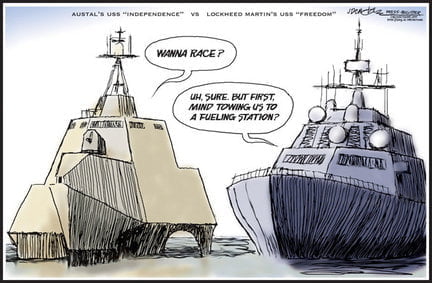In many ways, for critics of LCS this evolution was as inevitable as it was self-evident. As more hulls were pier-side speaking truth than PPT illuminating briefing rooms, expectations would have to change to stay inside the lines of credibility.
Dreams of stopping the run and pivot to building a better platform reached the equal-time-point an election cycle ago. We will have LCS, and it will inside a little more than a decade form a larger percentage of our Fleet. The question remains – what will we actually be able to do with it given its known limitations, unknown tactical utility, and completely undeveloped mission modules that are the only thing that prevent it from being a +$600 million mobile 57mm gun with a flight deck?
Sydney J. Freedberg Jr. at AOLDefense has a nice review of the CNO’s speech at the National Press Club breakfast 12 APR that touched on LCS. Let’s do a little light fisking this Friday morning, shall we?
“These are not large surface combatants that are going to sail into the South China Sea and challenge the Chinese military; that’s not what they’re made for,” Greenert said of the LCS class.
OK. A warship that is 1.5′ longer than a Fletcher Class DD is not a large warship … but she is not small. South China Sea?
The South China Sea is a marginal sea that is part of the Pacific Ocean, encompassing an area from the Singapore and Malacca Straits to the Strait of Taiwan of around 3,500,000 square kilometres (1,400,000 sq mi). The area’s importance largely results from one-third of the world’s shipping transiting through its waters, and that it is believed to hold huge oil and gas reserves beneath its seabed. …
The South China Sea contains over 250 small islands, atolls, cays, shoals, reefs, and sandbars, most of which have no indigenous people, many of which are naturally under water at high tide, and some of which are permanently submerged. The features are grouped into three archipelagos (listed by area size), Macclesfield Bank and Scarborough Shoal:
So, we have a warship that has both “Littoral” and “Combat” in its name that we do not intend to challenge a regional navy with in an area full of littoral waters? Do we really mean that – or are we trying to tell the Chinese that even though we are putting Marines in northern Australia and warships in Singapore; we are only there to have quick access to nice liberty ports? Either way – that isn’t impressive.
As Undersecretary of the Navy Bob Work likes to tell us, the United States Navy does not need frigates. Think back to how we have used our frigates since the Vietnam War, and then square this statement;
“Littoral Combat Ships will tend to displace amphibious ships and destroyers in Africa and South America. That will free up surface combatants, more high-end ships … “
That is what your classic multi-mission FF/FFG has been doing for decades – a much more useful ship than a low endurance uni-mission LCS. Just saying.
The next fisk is sad.
I intend to go in harm’s way. - John Paul Jones
That is what we said once as a Navy. What do we say now?
“I don’t worry per se about its survivability where I would intend to send it,” Greenert said of the LCS. “You won’t send it into an anti-access area.”
Back that up a bit. Littoral is near land. Any land mass is, by its nature, going to be an anti-access area in a non-permissive environment. Are we really going to have a foundation Class of warship in our navy that we will not put in harm’s way?
That is just silly – of course we will. When it is the only ship around and you need things done, either you don’t do it or you ask LCS to. Also – why does it have weapons if you don’t need them against someone who can shoot back? We did build a Fletcher Class sized warship as “Level I” for a nation that is casualty adverse – so I guess that reality is sinking in.
This final bit of reimagining is actually a re-invention.
On that crisis, the CNO tried to strike a delicate balance between confrontation and conciliation.
The US and its Asian partners must stand ready to “confront” the Chinese when they trespass on international norms, Greenert said, but the real solution is to prevent a crisis in the first place through quiet confidence-building — including the kind of low-profile partnership and presence missions for which the Littoral Combat Ship is suited.
That describes something the Chinese are very familiar with – the gunboat. I think he is humming CAPT Henry J. Hendrix, Jr’s tune, but others may hear it differently.
The thing is – in the 20th century, we didn’t plan to have such a large portion of our Fleet be gunboats. Most of the low-level missions described above were handled by destroyers and cruisers for most of the century, joined by frigates in the later part … which did a good job in peace, and when it came time for war – were of actual use to the Fleet commander. LCS?
On balance – all the snarky fisking aside – this was a very good admission by the CNO. Though we won’t know for sure until an actual FMC mission module makes an appearance later this decade (we think) – at least we are as an institution starting to talk clearly about the sub-optimal nature of LCS and its limited utility.
Why is that good? It is good because when you send under-armed, under-manned, fragile warships in harm’s way – Sailors die wholesale. It is better to admit that in peace, than to learn it in war.
Republished with the permission of the author
http://blog.usni.org/2012/04/13/reimagining-lcs/
Credit Cartoon:



